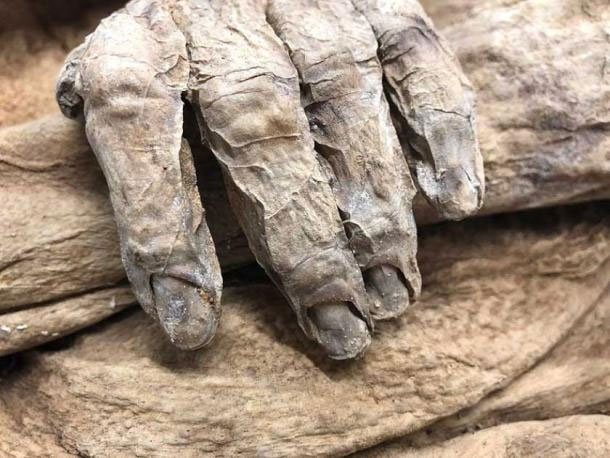The mummy described as Switzerland’s most mysterious has been examined by scientists again, revealing an unknown pathogen lurking in brain tissue.
According to Ancient Origins, the mummy mentioned is the body of Anna Catharina Bischoff, who died in Basel – Switzerland in 1787. She was discovered nearly two centuries later, by workers excavating at a church dating back to the time. Barfusser medieval.
The tomb is curious because it is a hidden brick-walled burial chamber just before the chapel’s choir. There are two coffins inside the crypt, in which the woman lies inside a simple spruce coffin, but in such good condition that her fingernails and hair are also intact.

The intact nails of the old woman show the extremely good preservation of the mummy – (Photo: ANCIENT ORIGINS)
A 2018 study by the Natural History Museum of Basel studied the mummy’s DNA and identified the mummy, as well as showing that she was a long ancestor of former British Prime Minister Boris Johnson.
A special burial area in the crypt below the old church was originally reserved for wealthy families in 18th-century Basel.
The results of an analysis in 1976 suggested that the 68-year-old woman died of syphilis, due to the presence of the chemical mercury sulfide in her lungs, which was once used to treat syphilis. This poison causes her to die, but also prevents the body from decomposing. Contributing to the special sealed condition of the coffin and crypt, she became a mummy naturally.

Unusual burial area inside the church – (Photo: ANCIENT ORIGINS).
Now, a new study led by microbiologist Mohamed Sarhan from Eurac Research (an Italian research institute) shows that the initial diagnosis was erroneous.
They analyzed Ms Bischoff’s brain tissue and found “an unknown pathogen”, containing genes found in a modern bacterium that causes bone damage and lung symptoms. This strain is also related to spirochetes of syphilis, the symptoms are similar, but not.
According to the authors, this finding has many major implications. One was the exoneration of this aristocratic woman, who was said to be the son of a pastor, then married a pastor and her 40-year marriage gave her seven children. The fact that she was suspected of dying of a sexually transmitted disease caused great controversy.
Second, the discovery of this unknown pathogen could also pave the way for much more important knowledge in the development of new infectious disease prevention and treatment methods, through a clearer understanding of the evolutionary history of the disease. evolution and spread of ancient pathogens.








